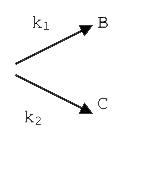The decomposition of hydrocarbon follows the equation k=(4.5×1011s−1)e−28000K/T
Calculate Ea.
To calculate the activation energy (E_a) from the given equation, we will follow these steps:
Step 1: Write down the Arrhenius equation
The Arrhenius equation relates the rate constant (k) to the temperature (T) and the activation energy (E_a):
k=Ae−EaRT
where:
- k = rate constant
- A = pre-exponential factor
- Ea = activation energy
- R = universal gas constant (8.314 J/(mol·K))
- T = temperature in Kelvin
Step 2: Identify the given equation
The given equation is:
k=(4.5×1011s−1)e−28000KT
Step 3: Compare the two equations
From the Arrhenius equation, we can see that:
e−EaRT=e−28000KT
This implies:
EaRT=28000KT
Step 4: Cancel out T
By multiplying both sides by RT:
Ea=28000K⋅R
Step 5: Substitute the value of R
Now we substitute the value of R:
Ea=28000K⋅8.314Jmol⋅K
Step 6: Calculate E_a
Calculating the above expression:
Ea=28000⋅8.314
Ea=232792J/mol
Step 7: Convert to kilojoules
To convert joules to kilojoules, divide by 1000:
Ea=232792J/mol1000=232.792kJ/mol
Final Result
Thus, the activation energy Ea is approximately:
Ea≈232.8kJ/mol
---
The Arrhenius equation relates the rate constant (k) to the temperature (T) and the activation energy (E_a):
k=Ae−EaRT
where:
- k = rate constant
- A = pre-exponential factor
- Ea = activation energy
- R = universal gas constant (8.314 J/(mol·K))
- T = temperature in Kelvin
The given equation is:
k=(4.5×1011s−1)e−28000KT
From the Arrhenius equation, we can see that:
e−EaRT=e−28000KT
This implies:
EaRT=28000KT
By multiplying both sides by RT:
Ea=28000K⋅R
Now we substitute the value of R:
Ea=28000K⋅8.314Jmol⋅K
Calculating the above expression:
Ea=28000⋅8.314
Ea=232792J/mol
To convert joules to kilojoules, divide by 1000:
Ea=232792J/mol1000=232.792kJ/mol
Thus, the activation energy Ea is approximately:
Ea≈232.8kJ/mol
Topper's Solved these Questions
- CHEMICAL KINETICSBOOK - NCERT ENGLISHCHAPTER - CHEMICAL KINETICSEXERCISE - Exercise
1 Videos
- CHEMICAL KINETICSBOOK - NCERT ENGLISHCHAPTER - CHEMICAL KINETICSEXERCISE - SOLVED EXAMPLE
1 Videos
- BIOMOLECULESBOOK - NCERT ENGLISHCHAPTER - BIOMOLECULESEXERCISE - Exercise
33 Videos
- CHEMISTRY IN EVERYDAY LIFEBOOK - NCERT ENGLISHCHAPTER - CHEMISTRY IN EVERYDAY LIFEEXERCISE - Exercise
32 Videos
Similar Questions
The decomposition of a hydrocarbon follows the equationk =(4.5×1011s−1)e−28000KT. Calculate Ea.
View SolutionThe decomposition of a hydrocarbon follows the equationk =(4.5×1011s−1)e−28000KT. Calculate Ea.
View SolutionThe decomposition of a hydrocarbon follows the equationk =(4.5×1011s−1)e−28000KT. Calculate Ea.
View SolutionThe rate constant for the first order decomposition of H2O2 is given by the following equation : log K = 14.2 - 1.0×104TK
Calculate E for this reaction and rate constant k if its half life period be 200 minutes. (Given : R = 8.314 JK−1mol−1)
View SolutionThe rate constant for a second order reaction is given by k=(5×1011)e−29000k/T. The value of Ea will be:
View SolutionA substance undergoes first order decomposition. The decomposition follows two parallel first order reactions as :
k1=1.26×10−4s−1,k2=3.8×10−5s−1
The percentage distribution of B and C are :

View SolutionThe decomposition of A into product has value of k as 4.5×103s−1 at 10∘C and energy of activation of 60kJmol−1. At what temperature would k be 1.5×104s−1?
View SolutionThe rate constant for the decomposition of hydrocarbons is 2.418×10−5s−1 at 546K. If the energy of activation is 179.9kJmol−1, what will be the value of pre−exponential factor?
View SolutionThe rate constant for the decompoistion of a certain reaction is described by the equation:
logk(s−1)=14−1.25×104KT
Energy of activation (in kcal) is
View SolutionThe rate constant for the decompoistion of a certain reaction is described by the equation:
logk(s−1)=14−1.25×104KT
At what temperature, rate constant is equal to pre-exponential factor?
View Solution
